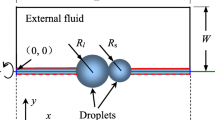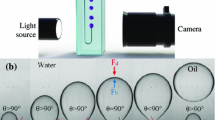Abstract.
The study of coalescence of polymer droplets is presented in the viscosity ratio range (p) going from 0.1 to 10. It is shown that the determination of the characteristic time of coalescence is a good way to estimate the interfacial tension. Polydimethylsiloxane (PDMS) is mixed with polyisobutylene (PIB) and the temperature change provides a way to modify the interfacial tension of the PDMS/PIB system significantly, as measured using a pendant drop apparatus. We obtain a dependence of the reduced coalescence time as a function of p–1/2 which gives access to the interfacial tension. This technique can be an interesting choice for estimating interfacial tension without requiring sophisticated techniques.
In a further attempt to correlate these observations with a theoretical model (Verdier C (2001) Polymer 42), the flow field inside and outside the droplets is investigated. PIV measurements are carried out where the evidence of elongational regimes is demonstrated. Such experiments are also interesting for future comparisons with numerical results.
Similar content being viewed by others
Author information
Authors and Affiliations
Additional information
Electronic Publication
Rights and permissions
About this article
Cite this article
Verdier, C., Brizard, M. Understanding droplet coalescence and its use to estimate interfacial tension. Rheol Acta 41, 514–523 (2002). https://doi.org/10.1007/s00397-002-0249-8
Received:
Accepted:
Issue Date:
DOI: https://doi.org/10.1007/s00397-002-0249-8




